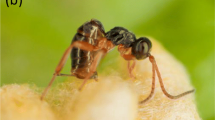Summary
Reproductive strategies have been investigated for three species of Dysdercus from Africa, D. intermedius, D. cardinalis and D. nigrofasciatus. Reproductive parameters were measured for each species on individuals cultured in the laboratory.
D. cardinalis is associated more with herbaceous than with arboreal host plants and is intermediate in body size. It tended to have the least age at first reproduction, reproduced most frequently, and layed the smallest clutches on average, spreading relatively high amounts of parental investment in more clutches than the other two species. It also laid the greatest number of clutches and eggs in a lifetime.
D. intermedius specializes on arboreal host plants, and is the largest of the three species. It had the greatest age at first reproduction, reproduced less frequently than D. cardinalis, and layed the largest clutches. Its parental investment over time declined earlier than that of D. cardinalis. D. intermedius layed the least number of clutches in a lifetime, but its lifetime gross reproduction was intermediate in magnitude.
D. nigrofasciatus has the widest diet breadth, and is the smallest in body size. Its age at first reproduction was similar to that of D. cardinalis, but D. nigrofasciatus reproduced least frequently, laying relatively large clutches. It was similar to D. intermedius in its pattern of parental investment over time, and essentially layed the same number of clutches in a lifetime as the latter species, although its lifetime gross reproduction was the smallest.
It is suggested that the reproductive strategies of the three species might have evolved as adaptations to selection events in the niches of the immature stages.
Similar content being viewed by others
References
Blueweiss L, Fox H, Kudzama V, Nakashima D, Peters, R, Sams S (1978) Relationship between body size and some life history parameters. Oecologia (Berlin) 37:257–272
Davis NT (1975) Hormonal control of flight muscle histolysis in Dysdercus fulvoniger. Ann Entomol Soc Am 68:387–405
Derr JA (1980) Coevolution of the life history of a tropical seed-feeding insect. Ecology 61:881–892
Derr JA, Alden B, Dingle H (1981) Insect life histories in relation to migration, body size, and host plant array: a comparative study of Dysdercus. J Anim Ecol 50:181–193
Dingle H, Arora G (1973) Experimental studies of migration in bugs of the genus Dysdercus. Oecologia (Berlin) 12:119–140
Edwards FJ (1970) Endocrine control of flight muscle histolysis in Dysdercus intermedius. J Insect Physiol 16:2027–2031
Fritz RS, Stamp NE, Halverson TG (1982) Iteroparity and semelparity in insects. Am Nat 120:264–268
Giesel JT (1976) Reproductive strategies as adaptations to life in temporally heterogeneous environments. Ann Rev Ecol Syst 7:57–79
Gillespie JH (1974) Natural selection for within-generation variance in offspring number. Genetics 76:601–606
Hassell MP, Southwood TRE (1978) Foraging strategies of insects. Ann Rev Ecol Syst 9:75–98
Hutchinson GE (1953) The concept of pattern in ecology. Proc Acad Nat Sci Philadel 105:1–12
Janzen DH (1969) Seed eaters versus seed size, number, toxicity and dispersal. Evolution 23:1–27
Janzen DH (1976) Why bamboos wait so long to flower. Ann Rev Ecol Syst 7:347–391
Lachaise D (1983) Reproductive allocation in tropical Drosophilidae: further evidence on the role of breeding-site choice. Am Nat 122:132–146
Lewontin RC (1965) Selection for colonizing ability. In “The genetics of colonizing species”. In: Baker HG, Stebbins GI (eds) Academic Press, New York, pp 77–94
Lewontin RC (1979) Fitness, survival and optimality. In “Analysis' of ecological systems”. In: Horn DJ, Stairs GR, Mitchell RD (eds) Ohio State University Press, Columbia, Ohio, USA, pp 3–21
Lloyd M, Dybas HS (1966) The periodical cicada problem, II: Evolution. Evolution 20:466–505
Murphy GI (1968) Pattern in life history and the environment. Am Nat 102:390–404
Pearson EO (1958) The insect pests of cotton in tropical Africa. Commonwealth Inst Entomol, London
Schaffer WM (1974) Optimal reproductive effort in fluctuating environments. Am Nat 108:783–790
Schmutterer H (1969) Pests of crops in northeast and central Africa. Gustav Fischer Verlag, Stuttgart
Sokal RR, Rohlf FJ (1981) Biometry, 2nd ed. Freeman, San Francisco
Southwood TRE (1962) Migration of terrestrial arthropods in relation to habitat. Biol Rev 37:171–214
Stearns SC (1976) Life history tactics: a review of the ideas. Q Rev Biol 51:3–47
Wilbur HM (1977) Propagule size, number and dispersal in Ambystoma and Asclepias. Am Nat 111:43–68
Winterholder B (1983) Opportunity-cost foraging models of stationary and mobile predators. Am Nat 122:73–84
Author information
Authors and Affiliations
Rights and permissions
About this article
Cite this article
Kasule, F.K. A comparison of the reproductive strategies of three species of Dysdercus from Africa (Hemiptera, Pyrrhocoridae). Oecologia 65, 260–265 (1985). https://doi.org/10.1007/BF00379226
Received:
Issue Date:
DOI: https://doi.org/10.1007/BF00379226




